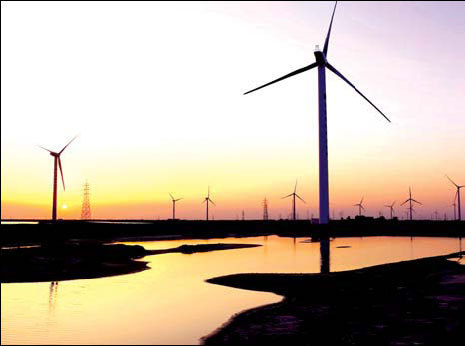Business
Wind power: good for suppliers, but rough for manufacturers
(China Daily)
Updated: 2010-12-07 14:10
 |
Large Medium Small |
 |
| The China Datang Corp's wind power project in Dongying, Shandong province. Zhang Renyu / For China Daily |
China's two largest power companies plan to list their wind units on the Hong Kong stock exchange, following similar moves by other Chinese wind companies, and are counting on investor interest, even while the Hong Kong market is in a slump.
The Huaneng Group, China's largest power producer, plans to take its subsidiary, Huaneng Renewables public this week, in a move that could raise up to $1.3 billion.
Meanwhile, China Datang aims to raise as much as $879 million for its renewables arm, China Datang Corp Renewable Power.
The listings underscore the confidence of a sector buoyed by government support and both have options that could increase the size of the offerings by 15 percent.
China has the world's fastest-growing wind market, and is putting up a wind turbine every hour. Wind power capacity is expected to increase five fold over the next 10 years, thanks to the government's clean energy drive.
Datang has raised $250 million in investments by big State-run enterprises such as the mining company Chalco, the State Grid, the steel producer Angang, and Yangtze Power, with dams in the Three Gorges area.
Huaneng has raised at least $140 million worth of commitments from State Grid, Bank of China, and Temasek, Singapore's sovereign wealth fund.
Chinese wind companies are eager to tap into capital markets to boost their international profile and have had around half a dozen listings in the past year.
These efforts stand in stark contrast to some struggling renewables in Europe, such as the Italian power company Enel's green power unit, which raised less than was hoped for in an initial public offering (IPO) in October.
Institutional investors have been cautious about the sector in the wake of poor performances in previous listings.
And China's investment in renewable energy stands in contrast to the rest of the world. The country spent about $10 billion in the second quarter of 2010 on wind energy alone - about half of the global total of $20.5 billion - according to an Ernst&Young report.
Analysts warn, however, that there are pitfalls ahead for these young businesses, especially wind-turbine manufacturers.
They have been struggling as China examines a law that would reduce the number of turbine-makers in an effort to avoid oversupplying the market.
This has become a key issue, and the competition is so fierce that manufacturers often end up supplying turbines at, or below, cost.
Chinese wind projects are doled out on the basis of cost per megawatt of installed capacity, instead of cost per MW over the lifetime of the project. This is a key factor in the race to the bottom for turbine makers, industry executives say.
So, turbine-manufacturers' listings have fared poorly: Mingyang listed in New York in October, only to see its stock slide; Xinjiang Goldwind, which makes roughly one-fifth of China's installed turbines, had to put its IPO off, from June to September, and reduce its size.
The operators have fared better, thanks in large part to government tariffs. Longyuan, China's largest wind operator, went public last December with a heavily subscribed IPO. Its price/earnings multiple is currently in the high-teens.
Huaneng and Datang are aiming for something similar.
"Wind-farm operators in China benefit from falling turbine prices, so it's a relatively attractive position to be in, as opposed to the turbine makers," says Charles Yonts, an analyst at CLSA.
One big question for operators and turbine makers alike is the future of the United Nations' clean development mechanism, a $2.7bn program that has helped fuel China's clean energy programs. The mechanism could expire after 2012, and the future price of carbon , if any, is unclear.